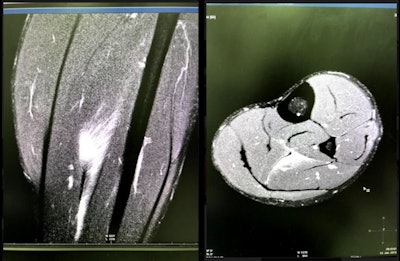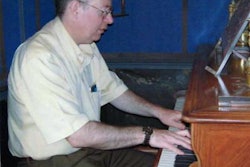
Dr. Michiko Dohi is a sports physician and radiologist based at the Japan Institute of Sports Science (JISS), where she is vice director. She took care of Japan's Olympic athletes at the Tokyo Games and was Japan's team doctor at men's and women's soccer World Cups. She also works closely with female athletes on topics such as menstruation, pregnancy, return to sport after giving birth, and sexual development disorders.
But how did it all begin? Why did she make the switch from radiology to sports medicine? And what's it like working closely with elite athletes? She provides some answers in an exclusive interview with AuntMinnieEurope.com.
 Dohi and her colleagues meet with Thomas Bach, the International Olympic Committee president, during the Tokyo Olympics. All images courtesy of Dr. Michiko Dohi.
Dohi and her colleagues meet with Thomas Bach, the International Olympic Committee president, during the Tokyo Olympics. All images courtesy of Dr. Michiko Dohi.Dohi's big break came in 2001. Football's governing body, FIFA, wanted to conduct doping control in women's tournaments in Asia and needed a female sports physician to carry out the tests. She was offered the position by her former teacher who, at the time, was a member of FIFA's medical committee and also worked for the Asian Football Confederation (AFC).
Dohi enjoyed the role, but she also had mixed feelings. She wanted to be a team doctor, and seeing teams with their physicians only made her interest stronger. At the time, sports doctors were generally orthopedic surgeons, cardiologists, or lung specialists, and many people were sceptical that a radiologist would make a good physician. This was compounded by the fact that the majority were male. Becoming a team doctor wasn't going to be easy.
However female sports were gaining ground. Her second break came in 2004, when the AFC needed a female sports medical officer based in Kuala Lumpur to work with women's teams across Asia and the Federation's administrator. Dohi learned how to organize medicine for Federation tournaments and train local physicians in the region.
Catching the cheats
Imaging, particularly MRI, has always been central to her work, she said. For instance, age cheating was in the spotlight in Asia, but because of the radiation from x-ray during bone maturity exams, FIFA and AFC were keen to pursue MRI age determination for young healthy subjects who participated in age-categorized competitions.
"I took the initiative to do MRI age determination for tournaments, using the grading system that FIFA had devised," Dohi explained.
 MRI has an essential role in imaging of football injuries. MR images (1.5 tesla sagittal and axial) show a muscle strain in a football player's lower leg. The strain occurred during the 2018 World Cup.
MRI has an essential role in imaging of football injuries. MR images (1.5 tesla sagittal and axial) show a muscle strain in a football player's lower leg. The strain occurred during the 2018 World Cup.She caught some overaged players, particularly in football, and also ran courses on the topic.
"As a teacher it was good to be both physician and radiologist. My aim was to keep sport fair. Now there are nearly no over-aged players in Asian football," Dohi said.
In 2006 she returned to JISS in Tokyo, where she had worked as a radiologist from 2002 to 2003. This time, she would be employed as a "sports physician" and would work with teams.
Multidisciplinary experts
"Before, sports medicine was poor but now it is mature. Our main role isn't patching up sprains, but is preventative," she noted.
 Dohi has given lectures on sports medicine across the globe. Here she speaks to members of the Confederation of African Football.
Dohi has given lectures on sports medicine across the globe. Here she speaks to members of the Confederation of African Football.She illustrated by explaining how a ligament injury undetected could cost a player six months of matches at great expense to the club. Early detection at the onset of a physical problem can prevent such a long recovery time. Besides injury, preventing other illnesses is also important, and this includes checking nutrition, pulmonary function, vision, heart, and mental health.
While her dream of becoming a sports physician was realized, Dohi is also proud of her background in radiology.
As a radiologist, Dohi believes she has an advantage over other sports doctors for certain aspects of the job -- but do all sports physicians need training in imaging? She thinks not, pointing out that pitch-side sports physicians don't need to be orthopedic surgeons either.
"The sports physician is multidisciplinary, serving as emergency doctor and GP. We're coordinators and need to know how and when to delegate to other specialists," she said. "We need the physical examination skills to make a diagnosis and speedy judgement as to whether the player can keep playing or needs to go to see a specialist or needs a few days' rest or a longer period of recovery."
Given the surge of interest in women's sport, there is a growing number of female sports physicians, according to Dohi. Young female doctors now have a greater chance of entering this specialty, but it is still not a high-status medical role, and salaries are not as high as those of hospital doctors.
At JISS, Dohi has helped establish a training center and clinic for elite athletes. Olympic team members and World Cup players are treated at this facility. Here Dohi, now an official Olympic team doctor, checks athletes before prestigious events such as the Asian Games in 2006, and the Beijing, London, Rio, and Tokyo Olympics.
World Cup imaging
In 2016, when already a team doctor for the women's national football team, Dohi also took on the role for the men's football team.
"The men's team had a French coach, and he insisted on a doctor who wasn't a surgeon but who was an internal medicine sports physician, for the work up in the qualifying tournaments for the 2018 World Cup. It helped that I could speak French!" she said.
 Dohi and her medical team are shown at the 2018 football World Cup in Russia.
Dohi and her medical team are shown at the 2018 football World Cup in Russia.Japan's qualifying games are in Asia this year, with the next World Cup to be held in Qatar in December 2022.
"I will be involved in conditioning the players for temperature, sleeping, nutrition and infection. MRI and portable ultrasound will be the mainstay for early detection of practice injury. The portable ultrasound will be kept in a hotel room in Qatar, but we will need to use local MRI for the final decision," she said, pointing out that for away competitions she accompanied players, when required, to MRI centers and checked the sequences, but she performed any ultrasound exams herself.
Diffusion MRI project
Besides her day-to-day fieldwork in elite sports, Dohi is involved in a concussion imaging project with one of her mentors, diffusion-imaging pioneer Prof. Denis Le Bihan, PhD, currently director of NeuroSpin, at the French Nuclear and Renewable Energy Commission at Saclay. Dohi has remained in contact with LeBihan since her time in Paris, when she studied functional MRI during a two-year stint between 1994 and 1996 at the Frédéric Joliot Hospital in Paris.
 French MRI pioneer Prof. Denis LeBihan was an important influence on Dohi during her time in Paris.
French MRI pioneer Prof. Denis LeBihan was an important influence on Dohi during her time in Paris.Concussion is difficult to diagnose, often underestimated by coaches and players, and can cause severe problems for athletes later, she noted.
"Concussion has no abnormal findings in MRI, but I am wondering if we can find abnormality in diffusion images and if this can impact concussion detection and patient management," Dohi noted.
"In this project, Dr. LeBihan is providing the protocol and aiding in analysis of our images. Initially, we may have found some small abnormalities but so far there are too few cases to be entirely sure whether these represent concussion or were preexisting abnormalities."
Making the move into sports medicine
When she graduated from Chiba University in 1991, Dr. Michiko Dohi knew she needed a career she could invest in for life. She had always loved sport and was a keen basketball player herself, but at the time, sports medicine in Japan was a little-known specialty, and the field was looked down on as "simple" by hospital doctors and the public alike.
Nevertheless, Dohi knew that sports physicians did more than fix broken bones, and she looked for a university with a sports medicine faculty. Her professor encouraged her to choose radiology as her specialty as it was fundamental to all diagnoses, and in 1991, she embarked on a two-year internship at Jikei University School of Medicine. That same year she had her first opportunity to work in the medical room in the Athlete's Village at the World Athletics Championships in Tokyo.
 Dohi meets U.K. athlete Roger Black during the 1991 Athletics World Championships in Tokyo. This was the first major sports competition at which she worked as a doctor.
Dohi meets U.K. athlete Roger Black during the 1991 Athletics World Championships in Tokyo. This was the first major sports competition at which she worked as a doctor.The 1990s was a booming time for MRI in clinical practice, providing many opportunities for research, and Dohi began to understand its high potential.
"Before, we could only see soft tissue with ultrasound and fracture with x-ray, and ligament & muscle injuries were difficult to detect. With MRI we could make precise diagnoses for ligaments, muscle, and bone marrow, and in the brain," Dohi said.
In 1993, she joined the Jikei's radiology faculty as a radiologist and spent much of her time on sports imaging, with a view to leading it. She also regularly visited other hospitals to observe the few existing physicians practicing in the field perform physical exams of patients.
"At this time, I offered my opinion on the images, and learnt how to combine this information with the physical exam. It was a two-way street," Dohi noted. "However, there was no such specialty as 'sports medicine' or 'sports doctor,' only Japan's sports associations and the Association of Orthopedic Surgeons called us that."



















